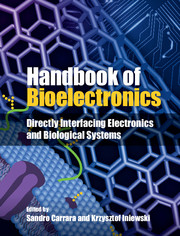Book contents
- Frontmatter
- Contents
- List of Contributors
- 1 What is bioelectronics?
- Part I Electronic components
- Part II Biosensors
- Part III Fuel cells
- Part IV Biomimetic systems
- Part V Bionics
- Part VI Brain interfaces
- Part VII Lab-on-a-chip
- Part VIII Future perspectives
- 40 Future perspectives in bioelectronics
- 41 Real-time activity energy expenditure estimation for embedded ambulatory systems using Sensium™ technologies
- 42 Electronic systems for health management
- 43 Linking the cyber and biological worlds: the Ensemble is the Function
- 44 Conclusion: Personal electronics and distributed theranostics
- Index
- References
42 - Electronic systems for health management
from Part VIII - Future perspectives
Published online by Cambridge University Press: 05 September 2015
- Frontmatter
- Contents
- List of Contributors
- 1 What is bioelectronics?
- Part I Electronic components
- Part II Biosensors
- Part III Fuel cells
- Part IV Biomimetic systems
- Part V Bionics
- Part VI Brain interfaces
- Part VII Lab-on-a-chip
- Part VIII Future perspectives
- 40 Future perspectives in bioelectronics
- 41 Real-time activity energy expenditure estimation for embedded ambulatory systems using Sensium™ technologies
- 42 Electronic systems for health management
- 43 Linking the cyber and biological worlds: the Ensemble is the Function
- 44 Conclusion: Personal electronics and distributed theranostics
- Index
- References
Summary
Introduction
Several important societal and economic world problems can be addressed by the smart use of technology. The past 40 years have witnessed the realization of computational systems and networks, rooted in our ability to craft complex integrated circuits out of billions of electronic devices. Nowadays, the ability to master materials at the molecular level and their interaction with living matter opens up unforeseeable horizons. Networking biological sensors through body-area, ad hoc and standard communication networks boosts the intrinsic power of local measurements, and allows us to reach new standards in health management. The Swiss Nano-Tera program addresses applications of nanotechnologies to health management, and it has been instrumental in fostering research and innovation in this domain.
The Nano-Tera program
Nano-Tera addresses system engineering research that leverages micro-, nano-, information, and communication technologies. The broad objectives of the program are both to improve quality of life and security of people across different levels of education, wealth and age, and eventually to create innovative products, technologies and manufacturing methods, thus resulting in job and revenue creation. Although the principal application domains are health and environment, energy and security issues are also investigated as support areas. The intrinsic value of the underlying research is to bridge traditional disciplines, including electrical engineering, micro/nano-mechanical systems engineering, biomedical sciences, and computer/communication sciences, with the objectives of (i) deepening the understanding of enabling technologies, (ii) reducing scientific concepts to practice, and (iii) mastering the novel challenges of designing large-scale complex systems.
- Type
- Chapter
- Information
- Handbook of BioelectronicsDirectly Interfacing Electronics and Biological Systems, pp. 543 - 549Publisher: Cambridge University PressPrint publication year: 2015



